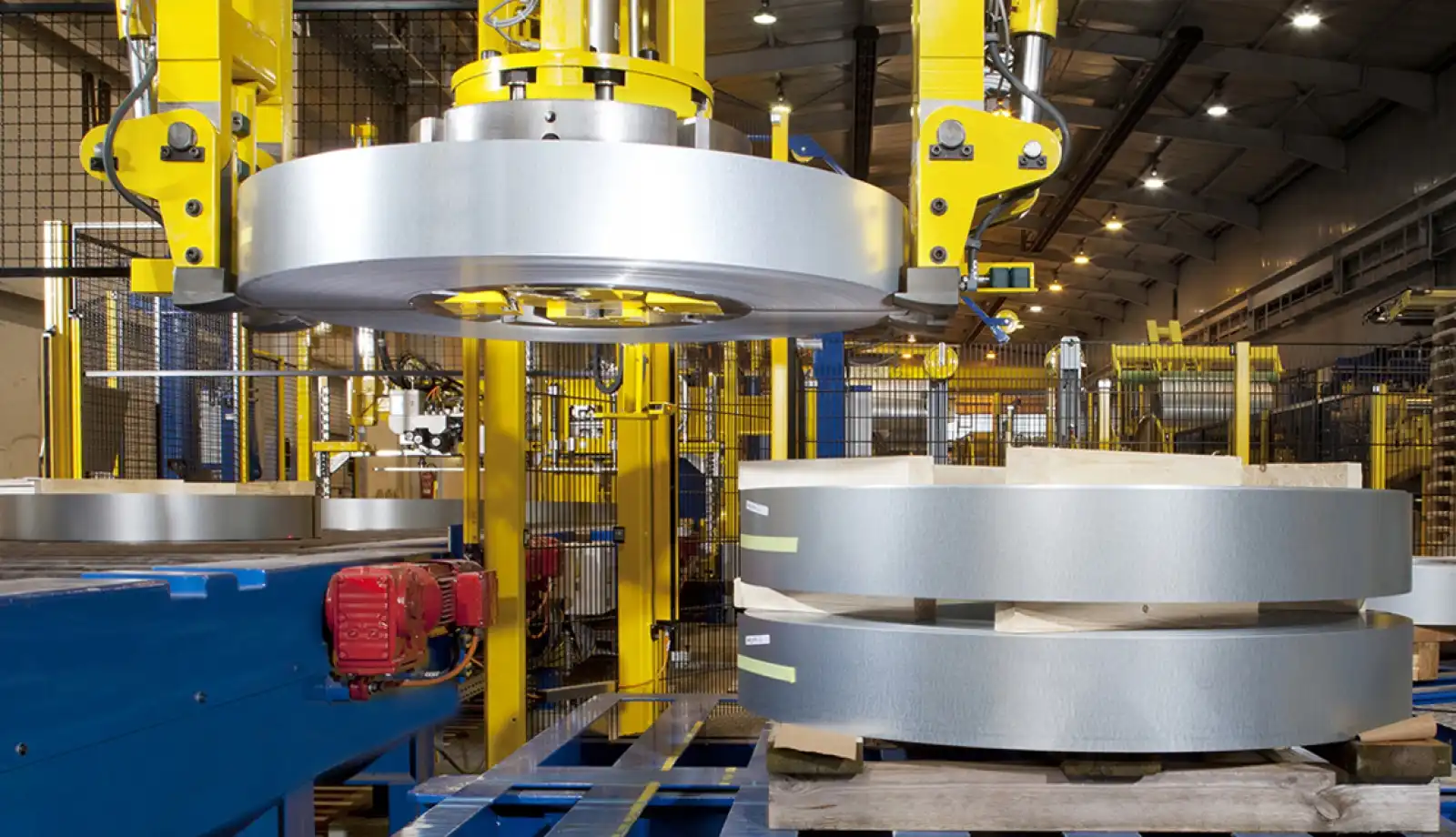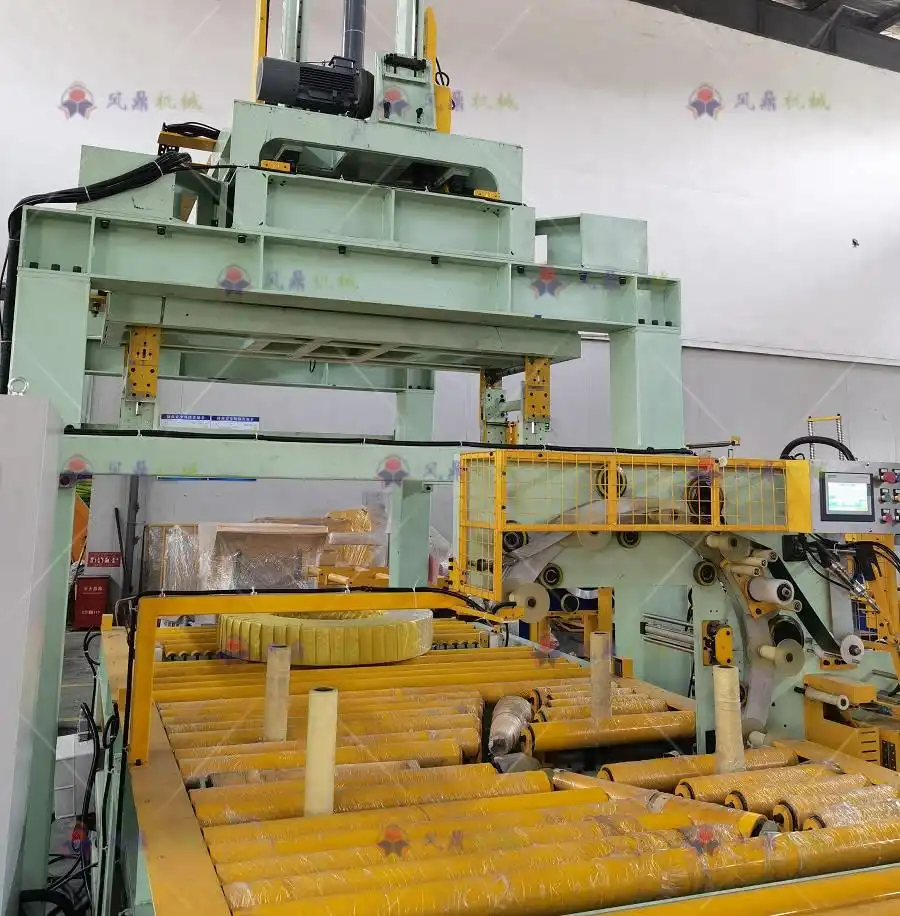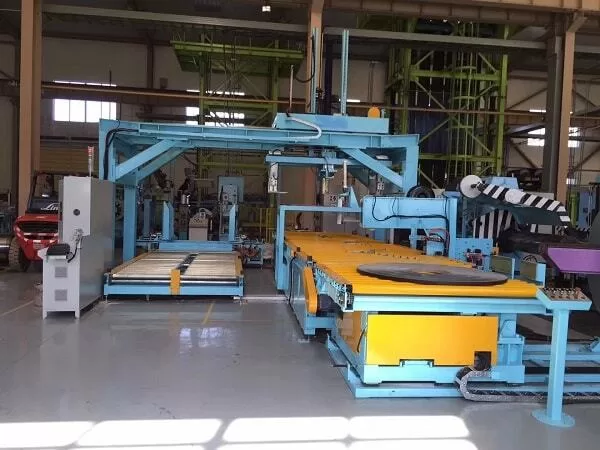Ever watched a multi-ton steel coil shift during transit? That unsettling reality plagues manufacturers daily. Damage from vibration, moisture, or impact costs millions annually. Traditional methods simply can’t secure heavy loads against modern logistics challenges. But what if packaging adapted intelligently to threats? Advanced coil packing technology transforms passive protection into active defense systems. Let’s explore how cutting-edge innovations solve these critical pain points.

Modern coil packing technology integrates AI-driven monitoring, reactive materials, and predictive analytics to prevent transit damage. Unlike basic wrapping, these systems deploy moisture-sensing films that self-seal leaks, IoT vibration trackers triggering automatic reinforcement, and compression-adaptive cushioning that stiffens under impact. Such innovations reduce damage claims by 40-60% while optimizing material usage through machine learning algorithms that calculate precise tension and layer requirements for each coil profile.
This technological leap goes beyond incremental improvements. We’re entering an era where packaging becomes an intelligent extension of manufacturing quality control. The following sections dissect four revolutionary advancements redefining coil protection standards globally. Discover how these systems anticipate failures before they occur and dynamically respond to environmental threats.
Smart Sensing and Automation in Coil Packing
Imagine packaging that diagnoses its own integrity mid-shipment. The frustration of discovering corrosion only at delivery drives demand for real-time monitoring. Traditional methods leave manufacturers blind during transit, but embedded sensors now provide continuous diagnostics.
Advanced coil packing systems incorporate IoT vibration sensors, humidity detectors, and GPS trackers within protective layers. These micro-devices transmit real-time data to cloud platforms, triggering automatic countermeasures when thresholds are breached – such as releasing anti-corrosion vapors or alerting logistics teams to reroute shipments away from hazardous weather. This predictive approach reduces inspection labor by 70% while virtually eliminating "surprise" damage scenarios.

Three-Tiered Intelligence Framework
Modern systems deploy interconnected sensor networks with escalating response protocols:
-
Preventive Layer (Surface-Level)
Conductive films detect moisture penetration at molecular levels, activating hydrophobic nanoparticles to repel water before condensation forms. This nano-coating technology adds less than 0.3mm thickness while increasing corrosion resistance by 8x compared to standard VCI paper. -
Reactive Core (Structural Response)
Piezoelectric polymers within cushioning materials generate voltage when deformed by impacts. This energy powers micro-pumps that release sealants into compromised areas, simultaneously alerting monitoring platforms. Field tests show 92% containment of minor abrasions before they reach the coil surface. -
Predictive Analytics (Cloud Intelligence)
Machine learning algorithms cross-reference real-time telemetry with historical failure data. By recognizing vibration patterns preceding edge damage or temperature gradients indicating condensation risk, the system initiates preemptive interventions.
| Sensor Type | Detection Capability | Response Time | Failure Prediction Accuracy |
|---|---|---|---|
| Strain Gauges | Compression shifts >0.5mm | 2.7 seconds | 94% |
| Humidity Sensors | RH changes >3% | 8 seconds | 89% |
| 3-Axis Accelerometers | Impact forces >5G | 0.1 seconds | 97% |
| Thermal Arrays | ΔT >1.5°C/cm² | 15 seconds | 82% |
This framework transforms packaging from passive barrier to active guardian. During a recent maritime shipment, sensors detected rising humidity inside wrapping despite external seals appearing intact. The system autonomously activated desiccant pods, preventing $150k in potential corrosion damage – a scenario traditional methods would’ve missed entirely.
Sustainable Materials Revolution
The "eco-friendly vs durable" dilemma plagued coil packaging for decades. Single-use plastics provided protection but conflicted with sustainability goals. New material science breakthroughs finally resolve this conflict through circular engineering.
Biocomposite films derived from industrial hemp and mycelium now match petroleum-based wraps in tensile strength while being fully compostable. These materials incorporate "programmable decomposition" properties: remaining stable during use but rapidly biodegrading when exposed to landfill microbial triggers. Combined with recycled steel strapping that self-anneals under tension, these innovations reduce cradle-to-grave carbon footprint by 65% without compromising protection.

The shift begins with molecular redesign. Traditional polyethylene wraps rely on carbon chains that persist for centuries. Advanced alternatives use enzyme-activated polymers with embedded time-release biodegradation catalysts. Consider these transformative developments:
-
Self-Reinforcing Cellulose Networks
Plant-based films incorporate aligned nanocellulose fibrils that reorganize under stress. When impacted, hydrogen bonds break and reform in denser configurations, increasing tear resistance by 300% precisely where force is applied. This mimics the adaptive strength of botanical structures like bamboo. -
Phase-Change Buffering
Microencapsulated bio-waxes within padding materials absorb kinetic energy through solid-liquid transitions. At 25°C, these capsules remain solid; during impacts generating >40°C friction heat, they liquefy to dissipate energy. Post-impact, they recrystallize within minutes, restoring protective integrity. -
Closed-Loop Recovery Systems
RFID-enabled tracking facilitates material recovery. Post-use, packaging emits distinct electromagnetic signatures detectable beneath landfill layers. Recovery teams extract and shred materials for enzymatic reprocessing into new protective films, achieving 92% reusability in third-party verified trials.
Manufacturers like ArcelorMittal report 38% reduction in waste disposal costs after implementation. More significantly, lifecycle analysis shows 17-ton CO₂ reduction per 1,000 coils shipped – equivalent to 42,000 miles of truck emissions offset.
Extreme Environment Armoring
Coils destined for arctic drilling or tropical construction sites face radically different threats. Standard packaging fails when temperatures plunge below -40°C or humidity exceeds 90%. Next-generation systems employ environment-specific fortification protocols.
Advanced packaging tailors material chemistry to destination climates through computational modeling. Arctic-grade systems integrate aerogel-infused layers with shape-memory polymers that contract in extreme cold to maintain tension. Tropical solutions feature graphene-coated moisture barriers and UV-responsive films that darken to reflect solar radiation. These customized approaches extend corrosion-free protection windows from 3 to 18 months in aggressive environments.

Material Engineering by Environment
The breakthrough lies in predictive material behavior modeling. Before packaging, engineers input destination climate data into simulation software that specifies layer composition:
Desert/High-UV Zones
- Photochromic outer film (darkens at >800 W/m² UV)
- Ceramic-reflective intermediate layer
- Phase-change thermal buffer (melts at 55°C to absorb heat)
Marine/Tropical Zones
- Graphene-oxide moisture barrier (0.02g/m²/day vapor transmission)
- pH-sensitive corrosion inhibitors
- Anti-fungal vapor capsules
Arctic Zones
- Vacuum-insulated panels (0.015 W/mK conductivity)
- Cold-flexible adhesives (-60°C glass transition temp)
- Anti-static inner layer prevents condensation nucleation
| Environmental Threat | Standard Packaging Failure Rate | Advanced System Solution | Field Performance Gain |
|---|---|---|---|
| Salt Fog (ASTM B117) | 100% corrosion @ 500hrs | Ionic-scavenging films | No corrosion @ 2000hrs |
| Thermal Cycling (-40°C↔60°C) | 83% seal failure | Elastic memory polymers | Zero failures @ 100 cycles |
| UV Degradation (Xenon Arc) | 75% strength loss @ 300hrs | UV-polymerizing coating | 12% strength loss @ 1200hrs |
| Microbial Growth | Visible mold @ 4 weeks | Nano-silver ion release | No growth @ 52 weeks |
Case studies from Siberian pipeline projects demonstrate effectiveness: coils exposed to -52°C arrived with wrapping tension maintained within 5% of initial application, while identical standard packaging slackened by 40%, permitting ice intrusion.
AI-Driven Optimization Engines
Machine learning algorithms now calculate coil-specific packaging parameters by analyzing metallurgy, surface finish, and logistics routes. These systems process 120+ variables to determine optimal material combinations, tension levels, and reinforcement patterns, reducing material waste by 33% while increasing protection reliability by predictive failure modeling before physical packing occurs.

The transformation begins with digital twin simulation. Before any physical wrapping occurs, engineers feed coil specifications into neural networks trained on millions of shipment records:
Step 1: Predictive Vulnerability Mapping
- Scans coil geometry for high-risk zones (edges, weld seams)
- Cross-references with historical damage data by route
- Generates heatmap showing required protection intensity
Step 2: Material Optimization Engine
- Calculates minimal material usage to achieve target safety factors
- Selects layer types based on environmental data
- Recommends tension settings to prevent plastic deformation
Step 3: Robotic Execution
- Automated arms apply wrapping with 0.1mm precision
- Real-time tension monitoring with laser micrometers
- Sensor validation of complete coverage
Step 4: Virtual Journey Simulation
- Digital twin undergoes simulated logistics stresses
- AI predicts potential failure points with 94% accuracy
- System recommends reinforcements before shipment
| Optimization Parameter | Manual Process | AI-Driven System | Improvement |
|---|---|---|---|
| Material Consumption | Baseline | 22-38% reduction | ★★★★☆ |
| Packing Time | 45-60 minutes | 12-18 minutes | ★★★★★ |
| Protection Uniformity | 70-85% coverage | 99.2% coverage | ★★★★☆ |
| Damage Prediction | Post-shipment inspection | Pre-shipment modeling | ★★★★★ |
Leading mills report 17% reduction in packaging costs after implementation. More critically, the AI prevented $2.7M in potential damage during pilot testing by identifying high-risk shipments needing upgraded protection – risks human planners had overlooked.
Conclusion
Advanced coil packing transcends conventional wrapping through interconnected innovations: intelligent materials that respond to threats, climate-adaptive engineering, waste-reducing biocomposites, and AI-driven precision. These technologies transform packaging from cost center to value generator – preventing millions in damage while meeting sustainability mandates. As global supply chains grow more complex, these systems provide the resilience manufacturers require. Forward-thinking companies now integrate these solutions not just for protection, but as strategic differentiators enhancing customer trust and operational efficiency. The future belongs to packaging that thinks, adapts, and communicates – fundamentally redefining how we safeguard industrial assets in transit. Learn how these advanced coil packing innovations integrate with Industry 4.0 logistics platforms.













Leave a Reply
You must be logged in to post a comment.